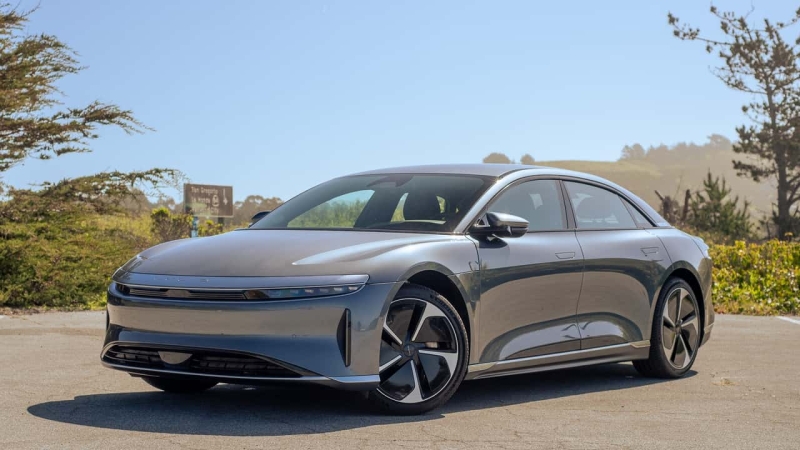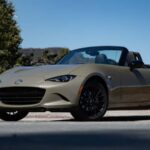The Lucid Air is delightfully straightforward, and the rear-wheel-drive Pure trim is its most-compelling form.
Before World War II, design in America was influenced heavily by Victorian-era sensibilities that emphasized the expression of wealth over livability. In America’s post-war boom, this ornamented, stuffy style fell in favor of modernism, which had its origins in the Weimar German Staatliches Bauhaus school. The Bauhaus rejected unnecessary ornamentation, and instead sought to unify all design under one universal principle: Form follows function.
Where Victorian architecture featured intricate craftsmanship and dimly-lit rooms with dark woods and deep tones, Bauhaus focused on clean lines and open, airy spaces. In its best implementations, the Bauhaus has influenced timeless design and tasteful luxury: Mid-century modern Eames chairs, the Helvetica font, and the International-Style UN World Headquarters in New York City all have roots in the Bauhaus.
The Lucid Air—especially in its most-attainable, most-efficient form, the new Pure RWD— deserves to be added to this list.
| Quick Specs | 2024 Lucid Air Pure RWD |
| Battery | 88.0 Kilowatt-Hour Lithium-Ion |
| Motor | Single Rear-Mounted |
| Output | 430 Horsepower / 406 Pound-Feet |
| Range | 419 Miles |
| Price | $71,400 |
At a glance, the car market is chock-full of attempts at modernist simplicity. Brushed aluminum, and flat dashes uninterrupted by physical buttons are commonplace, especially in luxury EVs like the Lucid Air. Many of these screen-centric minimalist interiors, however, are frustrating to use. Key functionalities are hidden in menus, concealed when they’re needed most. Important information goes undisplayed in the name of cleanliness. These cars frustrate drivers because, despite the modernist aesthetics, function has still taken a backseat to form, just like a Victorian-era fainting couch.
The Lucid Air’s cabin is truly modernist; despite a minimalist appearance, it focuses on usability first. Four buttons (fan and temperature controls for driver and passenger) and a stereo volume knob are the only physical controls. Everything else is controlled via a wrap-around 34-inch instrument/infotainment cluster paired with a center retractable screen Lucid calls the Pilot Panel. While driving the Air, I never needed to search more than one menu deep for any functionality aside from syncing a cell phone for the first time. As a result, I felt as though I’d mastered its cabin within an hour.
While in prior years, Lucid’s software was laggy and buggy for our reviewers, updates have cured these woes. I experienced no problems or lag in my Air Pure’s interface. Wireless Apple CarPlay, absent in previous models, is also now standard on all Lucids, including the base Air Pure. With music filling the cabin, I found the test car incredibly comfortable. The Pure shares the same intelligent drivetrain packaging as the rest of the Lucid lineup, which means it has a gargantuan 45.4 inches of front legroom and 37.6 inches of rear legroom. Leather upholstery has been swapped for a faux-leather alternative, but that is the only real difference from the rest of the Air lineup.
My sole complaint with the Air Pure’s cabin is that the trademark panoramic glass roof is replaced by a traditional aluminum one. This would not be a noticeable loss—the cabin stays significantly cooler—but the only headliners available for the Pure trim are covered in dark fabric. It makes the massive interior feel cramped. This oppressive colorway is the sole place the Air Pure fails the Bauhaus focus on airy design.
Outside the cabin, the Air does a fantastic job prioritizing function to create a pleasant form. Its efficiency-forward design gives the Lucid a 0.197 Cd, making it the most aerodynamic road car ever put into production, save for GM’s futuristic two-seater EV1. This results in the Air Pure RWD’s world-beating 137 MPGe (when equipped with 19-inch wheels), far ahead of its full-size luxury competitors (the BMW i7 and Mercedes-Benz EQS don’t crack triple digit MPGe ratings). Despite possessing the smallest battery pack Lucid offers (88 kWh), the Air Pure RWD achieves 419 miles of EPA-rated range. This is more range than any non-Lucid on the market, and gives it a market-topping 4.76 miles per kWh.
If efficiency doesn’t excite you, fear not: it’s still plenty quick. A rear axle motor producing 430 horsepower and 406 pound-feet of torque catapults the sedan to 60 in 4.5 seconds. It isn’t neck-snapping like higher trims, but it’s arguably the best driver’s car in the lineup, thanks to being the lightest by far. The Air Pure RWD weighs in at 4,506 pounds (around 800 pounds lighter than a twin-motor, long-range Grand Touring), and the weight loss feels noticeable in motion.
My test drive looped through California S.R. 84 and 35—Skyline Drive, one of the best driver’s roads in America—and the Pure was plenty fun. Despite lacking the front-wheel torque vectoring of the rest of the Air lineup, I found turn-in sprightlier than in all-wheel-drive trims. The steering rack is variable-ratio, but it is intuitive, accurate on-center, and I rarely needed to make corrections mid-corner. The body of the Air Pure never pitched or rolled excessively in tight corners, and yet it remained comfortable when cruising.
Unfortunately, like other Air models, the Pure RWD lacks the ability to turn off regenerative braking. That means driving spiritedly requires intense commitment to the throttle. This inability to preserve momentum easily, compounded with an indecisive-feeling brake pedal that fails to blend regeneration and the six-piston front calipers smoothly, means that truly driving hard is not enjoyable. Despite the lightweight rear-wheel-drive trim, the Air remains a 5/10ths car, not a 10/10ths one. That said, if it’s laid-back commuting and road tripping you’re after, it’s hard to imagine being dissatisfied with the Air Pure’s driving experience.
Given its wickedly competitive starting price—$71,400 after destination, undercutting the BMW i7, Audi E-Tron GT, and Mercedes-Benz EQS by roughly $30,000—the Air Pure RWD offers unbelievable value. The only way to get more range in an EV is to buy a higher-trim Lucid Air, and there simply is no car on the market that turns electrons into distance more effectively.
It prioritizes the right things in an EV—usability, range, efficiency—and despite the fact the Pure is the cheapest Lucid you can get, it never feels punitively stripped of functionality. Minimalism, when done properly, allows the purpose of a design to shine through clearly. Stripping the Air down to its purest essentials has resulted in Lucid’s finest car yet.
Competitors
- Audi E-Tron GT
- Tesla Model S
- Mercedes-Benz EQS
- BMW i7
Photos: Victoria Scott for Motor1
Gallery: 2024 Lucid Air Pure RWD Review
2024 Lucid Air Pure RWD
Motor Single Rear-Mounted
Battery 88.0 Kilowatt-Hour Lithium-Ion
Output 430 Horsepower / 406 Pound-Feet
Drive Type Rear-Wheel Drive
Speed 0-60 MPH 4.5 Seconds
Weight 4,506 pounds
EV Range 419 Miles
Seating Capacity 5
Cargo Volume 10.0 Cubic Feet (Frunk) / 22.1 Cubic Feet
Base Price $71,400



